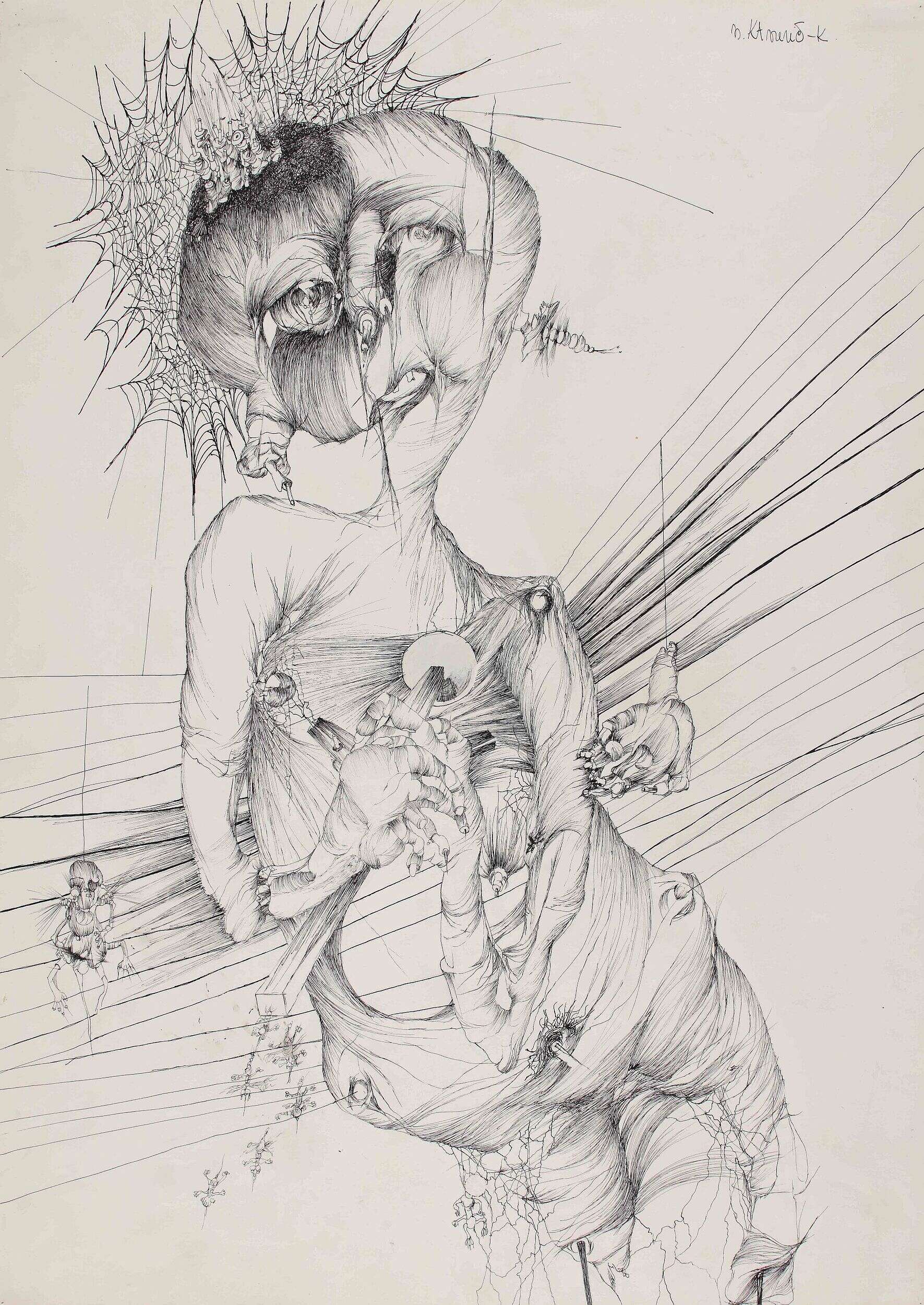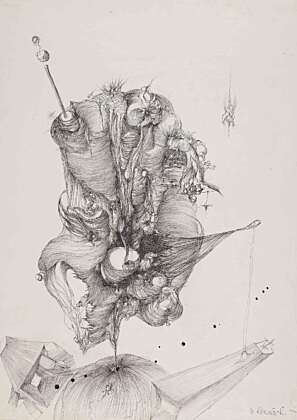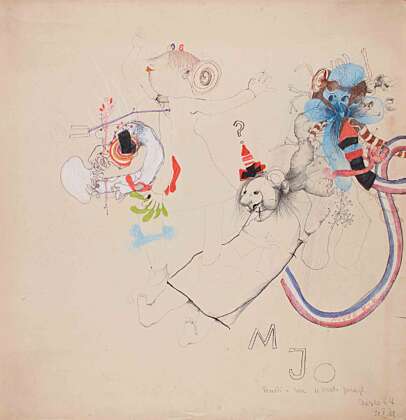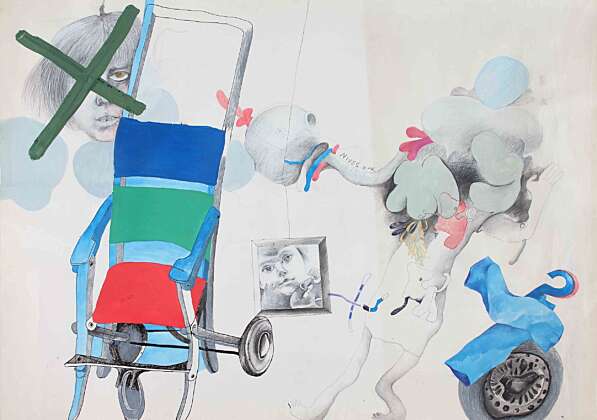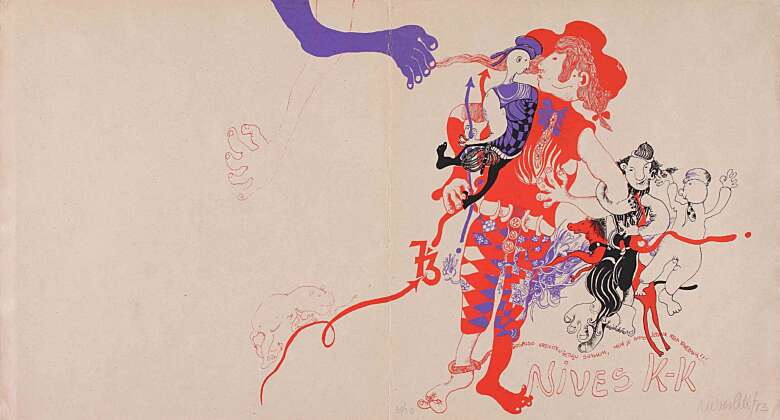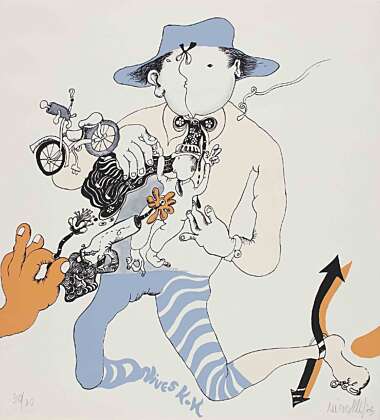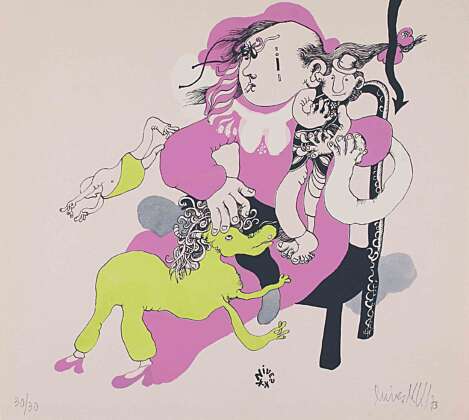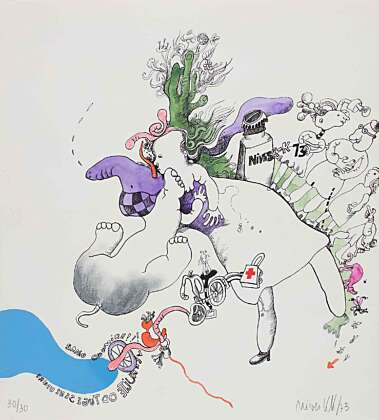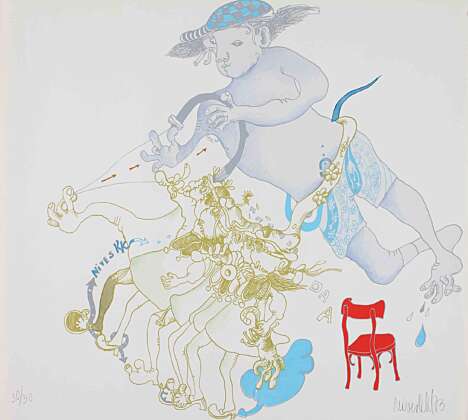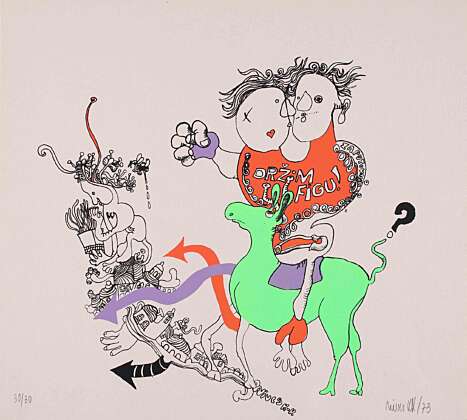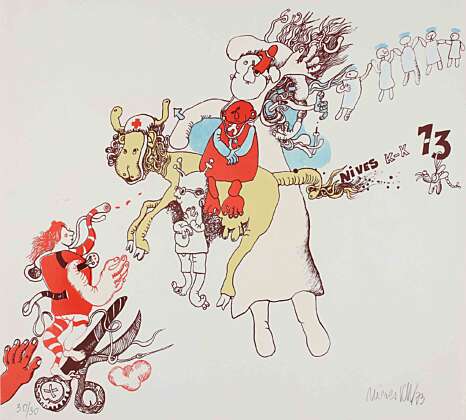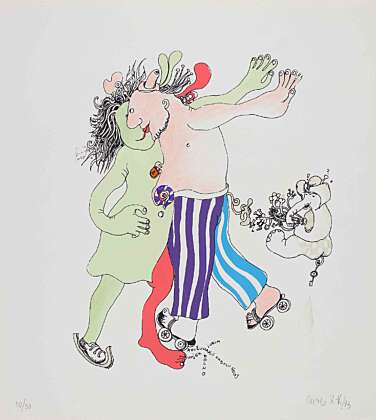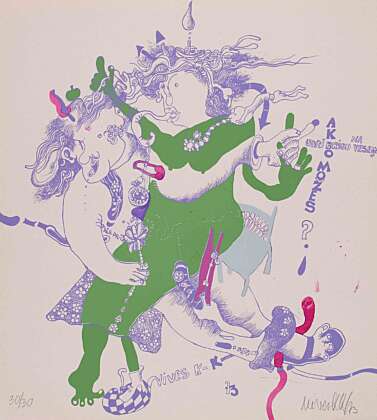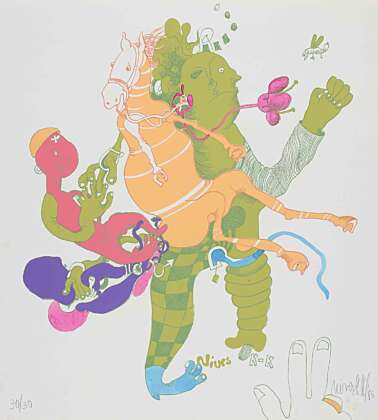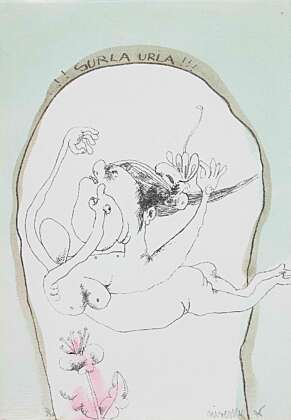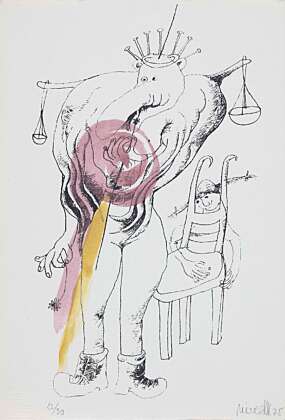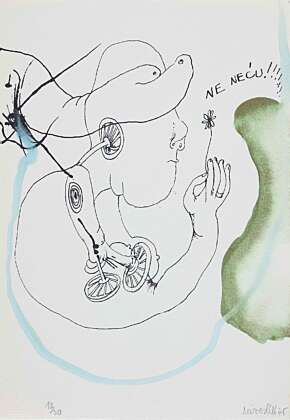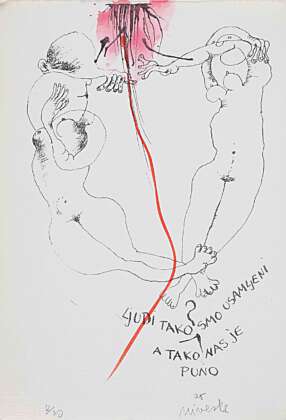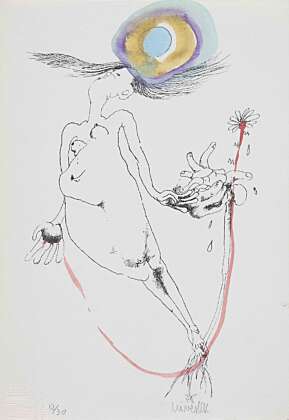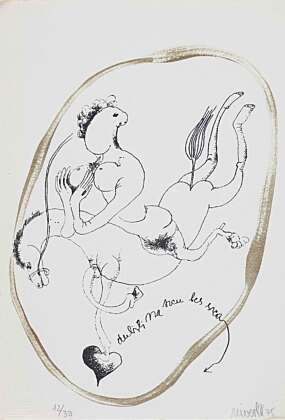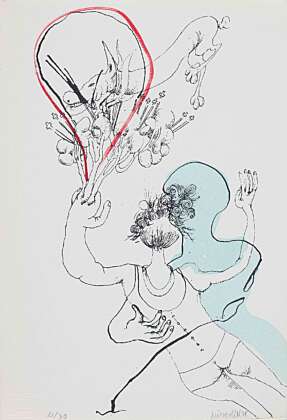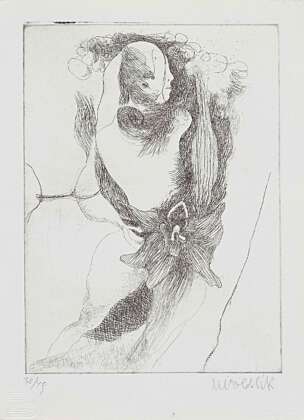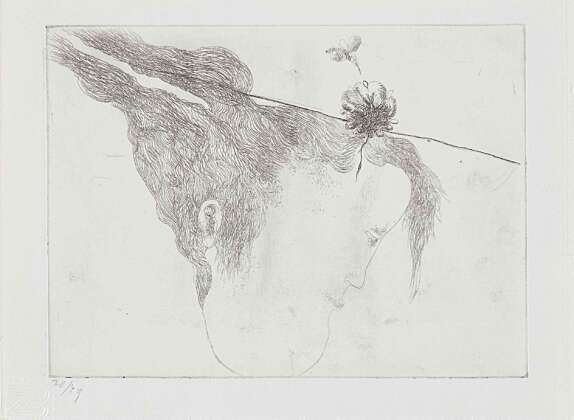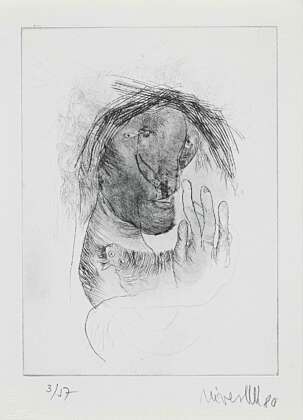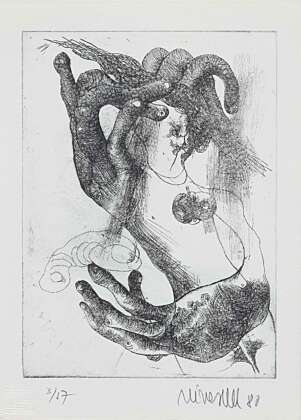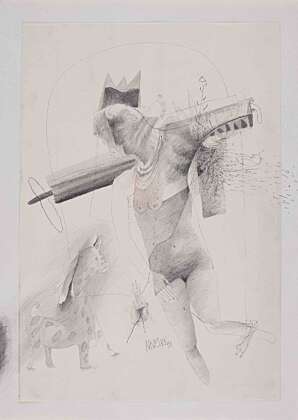The Confessional Imaginarium of Nives Kavurić-Kurtović
Artworks shown at Nives Kavurić-Kurtović's first solo exhibition, held at the Art Studio of the Department of Prints and Drawings in 1963, announced the visual modules of her anthropomorphic rhetoric, which she would in the coming years shape in harmony with her own spiritual and bodily states, modelling thereby an entirely personal psycho-descriptive handwriting. In the time dominated by abstract and reductive artistic trends, Nives Kavurić-Kurtović's pronouncedly morbid and bizarre poetics held in the Zagreb art milieu a special place, which soon became leading in the defence of formative aspects of the iconography of the transcribed reality . At that time, the artist received the Grand Prix at the Fifth Youth Biennial in Paris (1967) and became acknowledged as an author whose art reflects the tragic picture of the world, but not a literary demonstrational tragic vision of the world, such as is not rare in contemporary art, but rather a subjective and authentic one, which grew out of real life and has deep roots in the intimate biography of the author's childhood (R. Ivančević, 1990: 23). The earliest drawings, three of which form part of our holdings (Lažne svjetiljke / Faulty Lamps, Tegoba povratka / Hardship of Return, and Jer! / Because!) , are marked by an iconic in the styles of Kafka and Beckett, cloaked in misty existentialist atmosphere, and stigmatised by surrealism. We have singled out several fragments as seen by the critics of the time, who had recognised from the very beginning the artistic qualities and the stylistic-morphological orientation of Nives Kavurić-Kurtović's earliest works. Josip Depolo (1963: 9), emphasising a Bosch-like world of horrors (...) on the very verge of phantasmascopy, reviews her first solo exhibition as follows: With her pages of phantasmagorical anatomical atlases, with obsessive visions of foetuses and freaks, Nives Kavurić-Kurtović shows herself at first glance as a direct follower of surrealism.
The Confessional Imaginarium of Nives Kavurić-Kurtović
Artworks shown at Nives Kavurić-Kurtović’s first solo exhibition, held at the Art Studio of the Department of Prints and Drawings in 1963, announced the visual modules of her anthropomorphic rhetoric, which she would in the coming years shape in harmony with her own spiritual and bodily states, modelling thereby an entirely personal psycho-descriptive handwriting. In the time dominated by abstract and reductive artistic trends, Nives Kavurić-Kurtović’s pronouncedly morbid and bizarre poetics held in the Zagreb art milieu a special place, which soon became leading in the defence of formative aspects of the iconography of the transcribed reality [1]. At that time, the artist received the Grand Prix at the Fifth Youth Biennial in Paris (1967) and became acknowledged as an author whose art reflects the tragic picture of the world, but not a literary demonstrational tragic vision of the world, such as is not rare in contemporary art, but rather a subjective and authentic one, which grew out of real life and has deep roots in the intimate biography of the author’s childhood (R. Ivančević, 1990: 23).
The earliest drawings, three of which form part of our holdings (Lažne svjetiljke / Faulty Lamps, Tegoba povratka / Hardship of Return i Jer! / Because!) [2], are marked by an iconic in the styles of Kafka and Beckett, cloaked in misty existentialist atmosphere, and stigmatised by surrealism. We have singled out several fragments as seen by the critics of the time, who had recognised from the very beginning the artistic qualities and the stylistic-morphological orientation of Nives Kavurić-Kurtović’s earliest works. Josip Depolo (1963: 9), emphasising a Bosch-like world of horrors (…) on the very verge of phantasmascopy, reviews her first solo exhibition as follows: With her pages of phantasmagorical anatomical atlases, with obsessive visions of foetuses and freaks, Nives Kavurić-Kurtović shows herself at first glance as a direct follower of surrealism [3]. In the text Nadrealizam i hrvatsko slikarstvo / Surrealism and the Croatian Painting (1967: 53-54) [4], Igor Zidić, when writing about the drawings of 1962, points out that they, by aggressive descriptivism, pinpoint the details of corpses and carcasses, craters of decaying bowels, germinated brains, spread nerve webs, in contrast to the later works, in which he detects a loss of descriptive acuteness, and names the line the bearer of expression. In the monograph Nives Kavurić-Kurtović, Tonko Maroević (1986: 13-14) places these first works of obsessive themes and visions and of impregnated iconography of fateful events into the so-called black phase, and defines the global orientation of her art as surrealist and sub-realist. Željka Čorak (1968: 154), when analysing the artworks of the 1960s, argues that the most adequate label for her art is the term sub-realism [5], which is, contrary to the surrealist, widened registry of the relationship with the seen and the meant, ergo reshaped (sub-) consciousness, the embryo of the notion, or rather the holder of the meaning preceding unambiguousness.
The mid-1960s were marked by the beginning of the personal crystallisation or rather mastering personal stylistics (T. Maroević, 1986: 30). Nives brakes free from the morbid repository of motives, introducing a more playful and cheerful topical spectrum into her work, whilst replacing the strict and precise line of the ink by a more lapidary and twisted one (pencil, pastel, chalk, tempera), whereas the white paper surface gains a somewhat richer coloristic atmosphere. The bearer of these new shaping paradigms related to the new figuration and the inveterate personal repertoire, or rather system of signs (Ž. Čorak, 1968: 150) [6], is the drawing Vrijeme lutanja / Time of Wandering [7], kept in our holdings, which was exhibited together with the drawing Zalutali prostor / Stray Space at the First Zagreb Exhibition of the Yugoslav Drawing in 1968 that was organised by the Department of Prints and Drawings. On behalf of the jury, Zdenko Rus (1968: 144-145) wrote the explanation for the prizes awarded at this first biennial exhibition of drawings, where Nives Kavurić-Kurtović was awarded the first prize for her drawing Zalutali prostor / Stray Space: In the circle of the surrealists, the drawing of Nives Kavurić-Kurtović, who has justly been awarded one of the prizes, ought primarily to be pointed out. It is, of course, not surrealism in the classical sense. The impetus of the ‘art brut’ and the capability to remain in the imaginary sphere of a child offered a specific circle of unconscious motives converted into visual symbols, but even more importantly: the originality of expression and shaping (which obviously is a conscious process). Aggressive (receptive in fact) libidinous energy (in a broader sense of the word) has found its path, except in the mentioned perceptive formation, and in direct gestural flow; the highest value of this drawing lies therein.
This artist’s undoubtedly most intriguing artwork, kept in our holdings, is the drawing Realnost uzletište misli / Reality Runway of Thought [8] of 1970. It contains recognisable formative elements of her expression, drawn from personal preoccupations, experiences and frustrations, and reshaped into (un-) finished scenes on the verge of waking and sleeping, in which items and apparitions float in vacua of (un-) recognisable topoi, unstable perspectives and an atmosphere of (psychological) insecurity. Her personal iconography consists of anthropomorphic models marked by deformation as the ultimate imperative. This creates the idiomatic determinant in her art – constant slipping out of any artistic trend and/or movement, and creating a genuinely authentic reality of the picture [9].
In 1973, the Biškupić Collection published the portfolio of serigraphs entitled Nives K-K [10], Tonko Maroević (1986: 61) concludes as follows regarding this portfolio: it represents no solid demarcation line within her oeuvre, but does recognise it as a sort of denotement, as a moment of the consolidation of the vision and realisation, and as a sign of reconciliation with the outside world, though with no concessions to the reality, and disloyalty to inner requisitions. Away from the beginner’s dark and dreadful visions, in these works, Nives establishes a harmony of disharmony in scenes full of infantile and playful narratives, which, in the foreword to the portfolio, Vladimir Maleković [11] describes as erection of serenity, healing, drawer’s sardonic laughter, and soft spirit of irony, in contrast to the cadaver-like landscapes of the early drawings. Within the drawings occasionally occur lexical forms that, as interpretations of the metamorphosis of her visual world, additionally underline Nives’s powerful spiritual nature inclined to humour and ironic contradiction: (Gospodo krenite u šetnju sa mnom, meni je samo jedna noga zavezana!!! / Gentlemen, go for a walk with me, I’ve only got one leg tied!!!, Vjerujte od tuge se ne umire, samo odumire / Believe me sorrow does not make you die it only breaks you down,Udri brigu na veselje ako možeš / Forget your troubles and be merry, Rolšuhanje na bosu nogu uvijek bolno / Barefoot roller skating always painful…).
The collaboration with the Biškupić Collection [12] continued in several bibliophile publications, where prints by Nives Kavurić-Kurtović offered a visual completion of the verses by Mate Ganza and Tonko Maroević, as well as the texts by Marcel Béalu. With her original print sheets, she partook in the creation of the art portfolio Trag [13]. In the Surla edition [14], together with other painters who responded to the temptation of eroticism … with their artistic natures, Nives responded thereto with subtle transformation (T. Maroević, 1981: 17) including indications of ambiguous and often witty erotic experiences, with recognisable syntagms of a profound emotion: Ljudi tako smo usamljeni a tako nas je puno / People, we are so lonely, and yet there are so many of us, Dubiti na srcu bez srca / Upside Down on the Heart with no Heart, Surla urla! / The Trunk Shouts!. Unlike the scenes from the Surla / The Trunk [15], the drawing Slutnja ploda / Premonition of Fruitage[16] of 1977 emits a much more subtle atmosphere, marked by fine tones of experience of love, sublime honesty in presenting self-portrait-like reductions, and stylisations of fraught states of body and mind. In the copper etchings from two poetic-print portfolios of 1980 – Na rubu krova [17] i U koži i iz kože [18], although the author’s contour line remains the same, visual scenes become more robust and clearer in focus thanks to straight-line copper hatchings. Seen from the presenter’s angle, the review sequence ends by the drawing Rasuta tišina II. / Scattered silence II of 1991, which was shown at the 14th Zagreb Exhibition of Drawings in 1993 [19]. In it, we can sense loyalty to the iconic of twisted figuration arisen from profound introspection wrapped up in an aura of realistic experiences and spiritual passions.
Dedication to figuration, imperative in the yearlong creative career of Nives Kavurić-Kurtović, is a reflection of the persistence of her expression in form. The integrity of the contour line of the drawing, incorporated in the underlying concept of her oeuvre including diverse media, kept 0changing in accord with morphological and semantic art- and shape-related turbulences and amplitudes over the years. In retrospection, the instinct for destruction, oriented towards the rules of anthropomorphism, shaped a figurative idiom within the framework of the terminological determination of the aesthetic of ugliness, apprehended in the range from downhearted to light-hearted motivic expression. Iconic modules appearing as a constant in her imaginary narratives (spirals, hands, hearts, arrows, question marks, etc.), lucidly interwoven with (self-) ironic lexical constructs, add to the sublimely candid artistic expression, adopted from immense expanses of imagination and experience, and compressed into an intimate format of artwork.
Ružica Pepelko
[1] Zdenko Rus, when tackling the influence of the new figuration and the new realism in Nives Kavurić-Kurtović’s painting, concluded that she has assimilated several elements characteristic of these movements, however through a thick filter of her visionary and spontaneous subjectivity; in the exhibition catalogue: 22. Zagrebački salon. Kritička retrospektiva. Postojanost figurativnog 1950 – 1987. / 22nd Zagreb Salon. Critical Retrospective. Persistence of Figuration. 1950–1987. Art Pavilion, Zagreb, 1987, p. 120.
[2] Drawing Jer! / Because! , shown at the first exhibition at the Art Studio of the Department of Prints and Drawings in 1963, was bought off for the Department holdings from Mr. I. Marković in 1989, whilst the drawings Tegoba povratka / Hardship of Return and Lažne svjetiljke / Faulty Lamps were bought off from the author (minutes, 7th department session, 9 July 1963. Archives of the Department of Prints and Drawings of the Croatian Academy of Sciences and Arts).
[3] In the interview given to Ž. Koščević for the magazine Polet in 1967, Nives Kavurić-Kurtović defined her art as surrealism, however not of Dali-like type, because that surrealism is too fixed, overly static. Yet I like surrealism, in fact all that is good is surreal.
[4] Within the framework of the surrealist determination of her work, Zidić further mentions the term sub-realism when describing the cadaveric topics in her art in the context of the syntagm the space of the grave, taken over from the Belgrade surrealist trends of that time.
[5] Though recognising components of surrealism, abstract art and new figuration in her art, she nevertheless argues that the term sub-realism is the most appropriate one.
[6] Željka Čorak, when analysing the paintings and drawings of 1967 and 1968, observes in them a pure and concentrated line, and a take-off of the positive form. The human figure is of augmented dimensions and better defined, whereby it comes closer to the new figuration. The system of signs includes hearts, arrows, palm- or footprints, and flowers.
[7] In 2009, Renata Gotthardi-Škiljan, yearlong director of the Department of Prints and Drawings, donated to the Department the drawing that she received as present from the author after the 1st Zagreb Exhibition of the Yugoslav Drawing.
[8] In 1971, the City Fund for Fostering Cultural Activities bought the drawing off from the author for the Department holdings after the 3rd Zagreb Exhibition of the Yugoslav Drawing.
[9] In the chapter Psychoanalysis and the Collective Dream in Art in: Prodori moderne umetnosti / Breakthrough of Modern Art (Nolit, Belgrade), Bihalji-Merin (1962: 61) tackles Freud’s discoveries of sub-textual, subconscious and unconscious instincts as psychic reality, which stimulate the artists’(modern) striving towards crossing the traditional boundary of rationalism and logical cognitive reality, arising from dreams, phantasy and presentiment, forming a new ‘surreal reality’.
[10] From the impressum of the portfolio: The printing of the portfolio was finalised in June 1973 in combined technique: silkscreen, ink, chalk, watercolour and pastel. The portfolio includes 13 original print sheets /with cover page / signed and marked by numbers 1–30 by the author. Ten author’s copies were marked by numbers I–X. Foreword: Vladimir Maleković. Publisher: Zbirka Biškupić. Print: Istvan Konya – Branimir Rogić / Slavoljub Lacković.
[11] Maleković, Vladimir (1973), foreword to the portfolio Nives K-K, Zbirka Biškupić, Zagreb. The portfolio was bought off for the Department of Prints and Drawings by the City fund at the author’s exhibition in 1973.
[12] Author of the prints published in portfolios of the Biškupić Collection: Nives K-K (serigraphy, foreword by V. Maleković, 1973); Dalje ništa / Dvojba (serigraphy, verses by M. Ganza, 1976); Au bord du toit / Na rubu krova (copper etchings, text by M. Béalu, 1980); U koži i iz kože (drypoint, copper etchings, verses by T. Maroević, 1980); and as co-author of the portfolio Trag (1979).
[13] Together with seven other artists, who jointly composed the portfolio Trag: Ivan Kožarić, Ivan Lacković-Croata, Ivan Lovrenčić, Ljubomir Stahov, Dimitrije Popović, Ivica Šiško, and Miroslav Šutej. In our holdings, there is one copper etching by Noves Kavurić-Kurtović from this portfolio (inv. no. KG HAZU 8180), bought off by the Republic and City Culture Agency in 1980 at the 11th Zagreb Exhibition of the Yugoslav Print.
[14] There are 13 volumes of erotic poetry and prints issued under an ambiguous title. On the Biškupić Collection editions, find more in: Maroević, Tonko (1981), Autorski oslikana knjiga, Bibliofilska izdanja Zbirke Biškupić. Grafička zbirka Nacionalne i sveučilišne biblioteke, Zagreb, pp 9–21.
[15] In 2015, the author donated a copy of the poetic-print portfolio Dalje ništa Mate Ganza / Dvojba Nives Kavurić-Kurtović to the Department of Prints and Drawings.
[16] Buy-off by the Republic and City Culture Agency at the 7th Zagreb Exhibition of the Yugoslav Drawing in 1979.
[17] Au bord du toit Marcel Béalu / Nives Kavurić-Kurtović 12 engravings, Iris Edition, portfolio 5. Publisher: Biškupić Collection, Zagreb, 1980. Text in Croatian and French. Circulation: 49 copies. Printed of 250 gr. Hahnemühle Bütten paper (from: Bibliografija i dokumentacija M. Fruk i B. Biškupić, in: Bibliofilska izdanja Zbirke Biškupić. Grafička zbirka Nacionalne i sveučilišne biblioteke, Zagreb, p. 36). Nives Kavurić-Kurtović donated the portfolio to the Department of Prints and Drawings in 2015.
[18] From the impressum of the portfolio: the collection of poems U koži i iz kože by Tonko Maroević was first published on 17th October 1980 in Zagreb in the Arbor edition, which was established, edited and designed by Božo Biškupić. The poems were printed on 150-gram Hahnemühle Bütten paper in 57 copies. Print: GRAFI-KON, Zagreb. Nives Kavurić-Kurtović printed in every copy 12 engravings on 300-gram Hahnemühle Bütten paper in the techniques of drypoint and copper etching. The Collection is a joint edition of the poet, the painter and the Biškupić Collection. Nives Kavurić-Kurtović donated the portfolio to the Department of Prints and Drawings in 2015.
[19] In 1993, the drawing was bought off for the holdings of the Department of Prints and Drawings from the author after the 14th Zagreb Exhibition of Drawings.

No title I
from the poetic-print portfolio U koži i iz kože
by Tonko Maroević and Nives Kavurić-Kurtović,
ed. Arbor of the Biškupić Collection, Zagreb, 1980

No title II
from the bibliophile-print portfolio Au bord du toit
by Marcel Béalu / Nives Kavurić-Kurtović //
Na rubu krova by Marcel Béalu and Nives Kavurić-Kurtović,
ed. Iris of the Biškupić Collection, Zagreb, 1980

The Trunk / Touching Thought to Socialize
Dvojba by Nives Kavurić-Kurtović,
ed. Surla of the Biškupić Collection, Zagreb, 1976

The Trunk Shouts!
Dvojba by Nives Kavurić-Kurtović,
ed. Surla of the Biškupić Collection, Zagreb, 1976
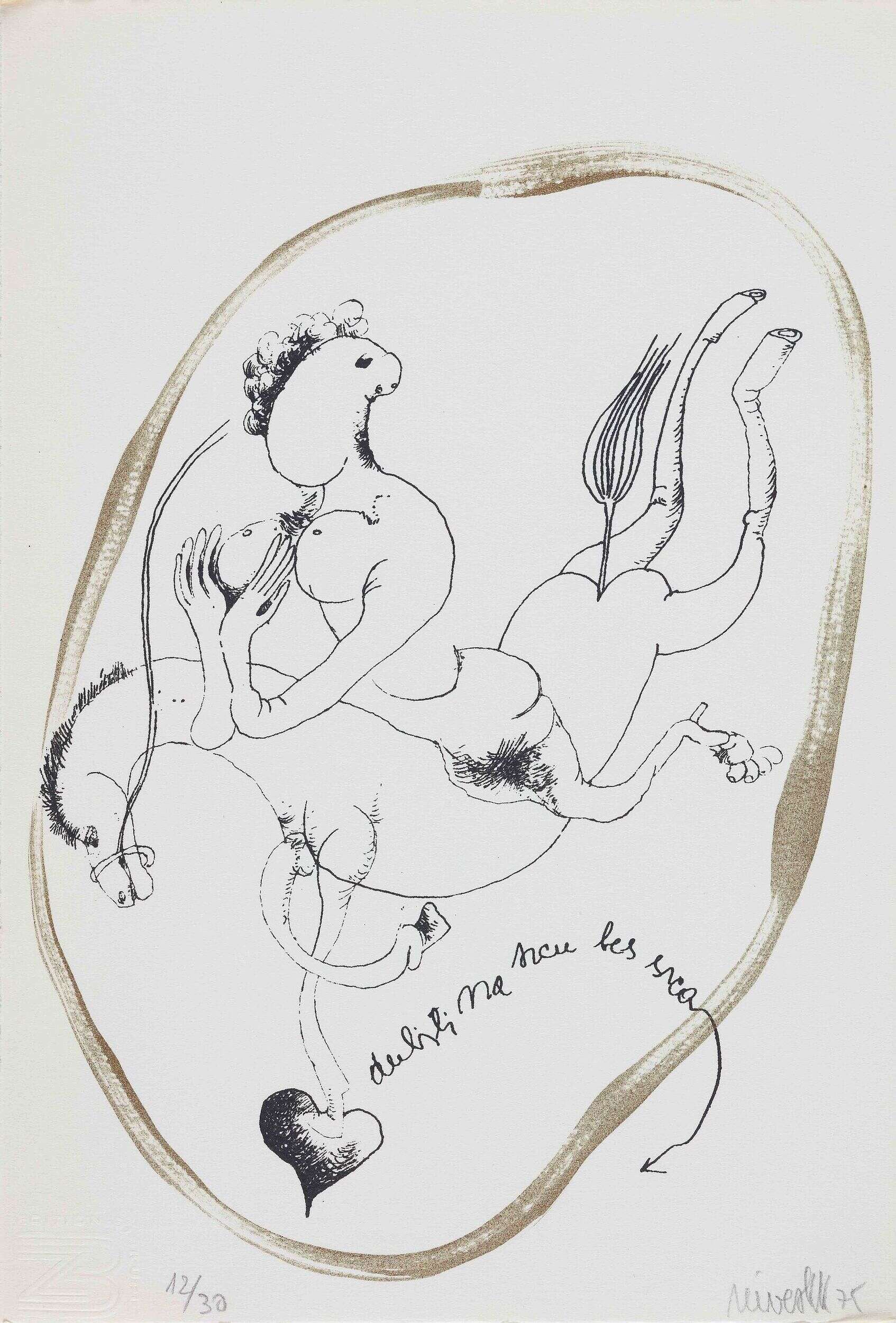
Upside-down on the Heart with no Heart
Dvojba by Nives Kavurić-Kurtović,
ed. Surla of the Biškupić Collection, Zagreb, 1976
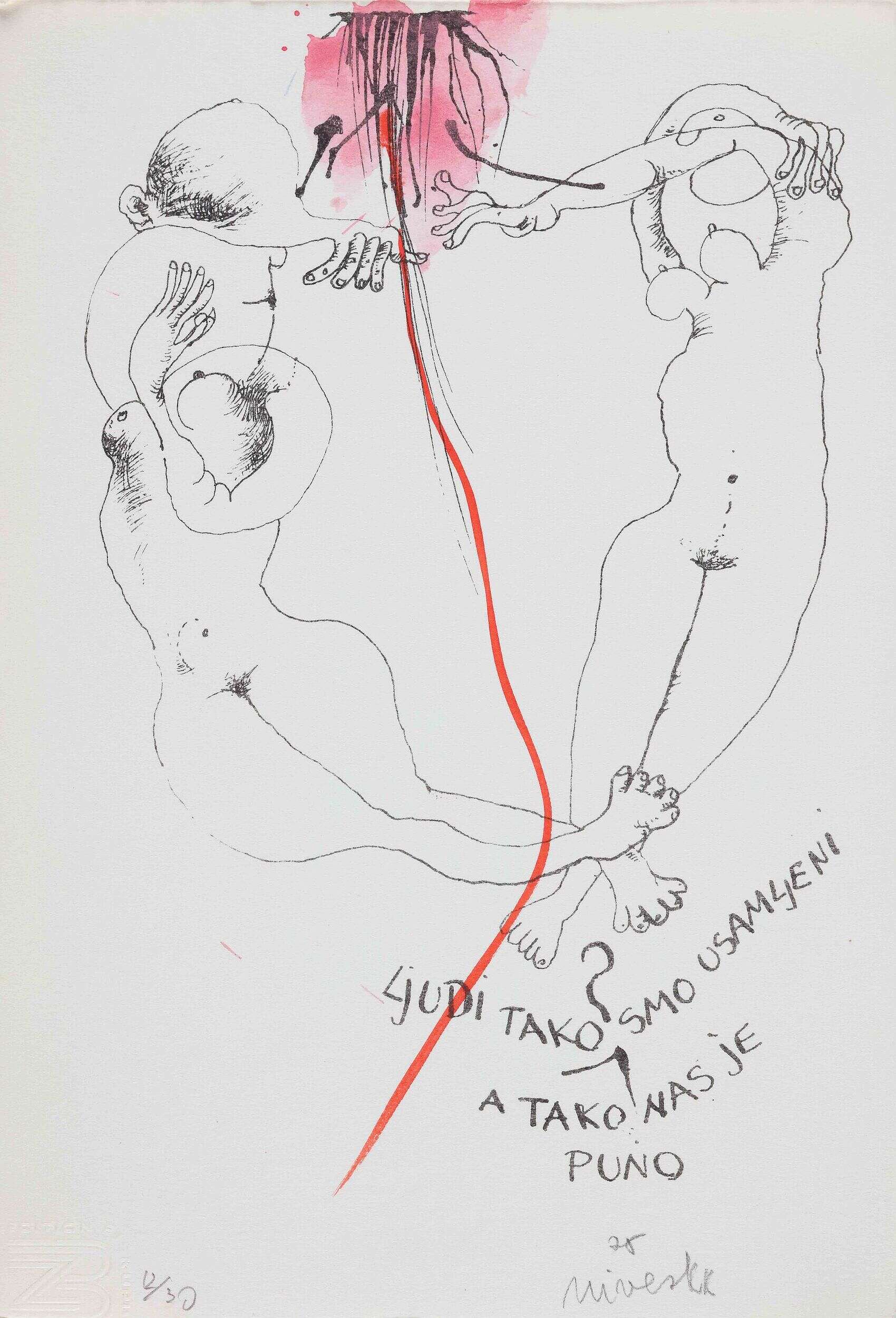
People, we are so lonely, and yet there are so many of us
Dvojba by Nives Kavurić-Kurtović,
ed. Surla of the Biškupić Collection, Zagreb, 1976
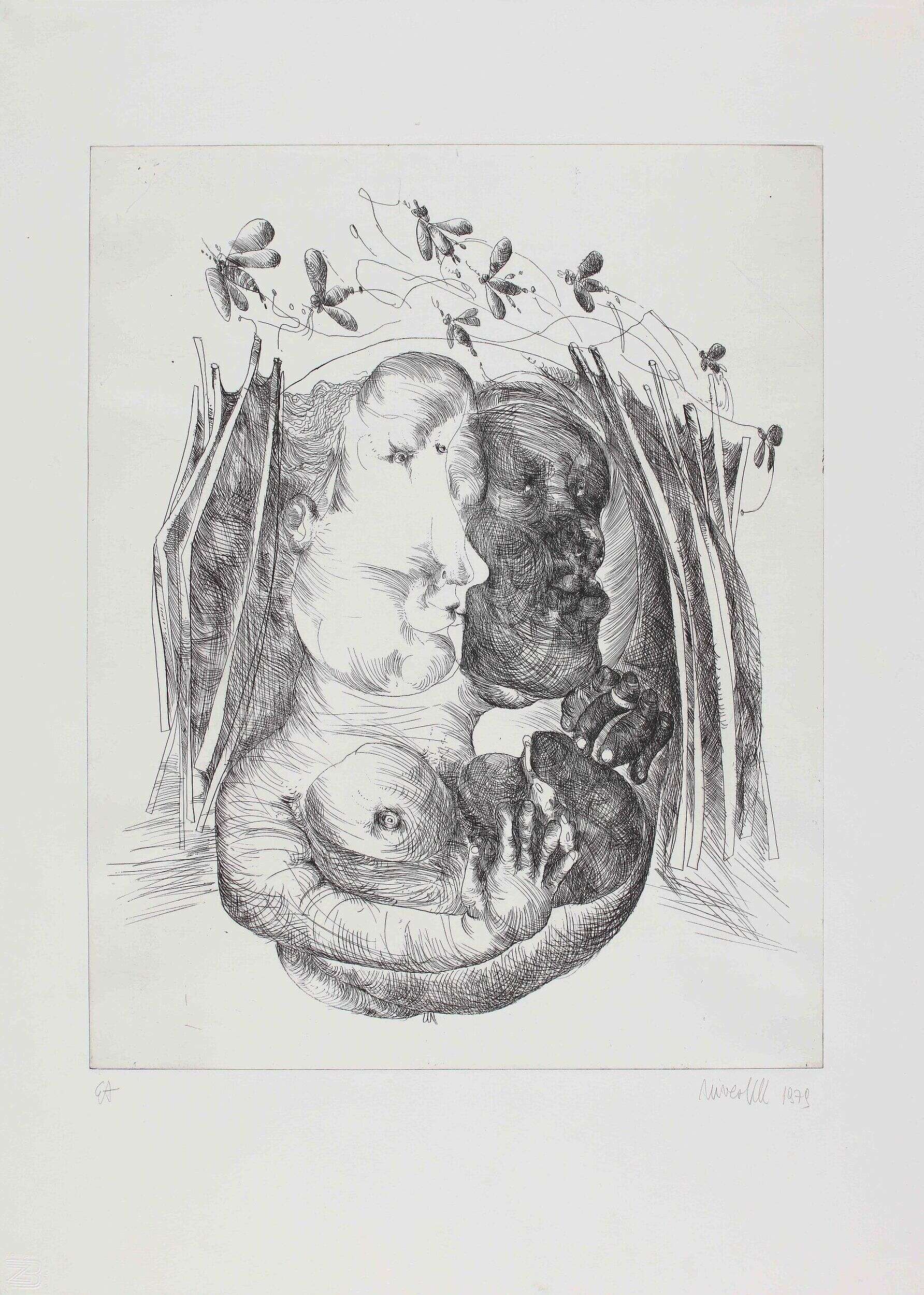
No title I
ed. of the Biškupić Collection, Zagreb, 1979

Barefoot Roller Skating
ed. of the Biškupić Collection, Zagreb, 1973

Forget your Troubles and be Merry
ed. of the Biškupić Collection, Zagreb, 1973
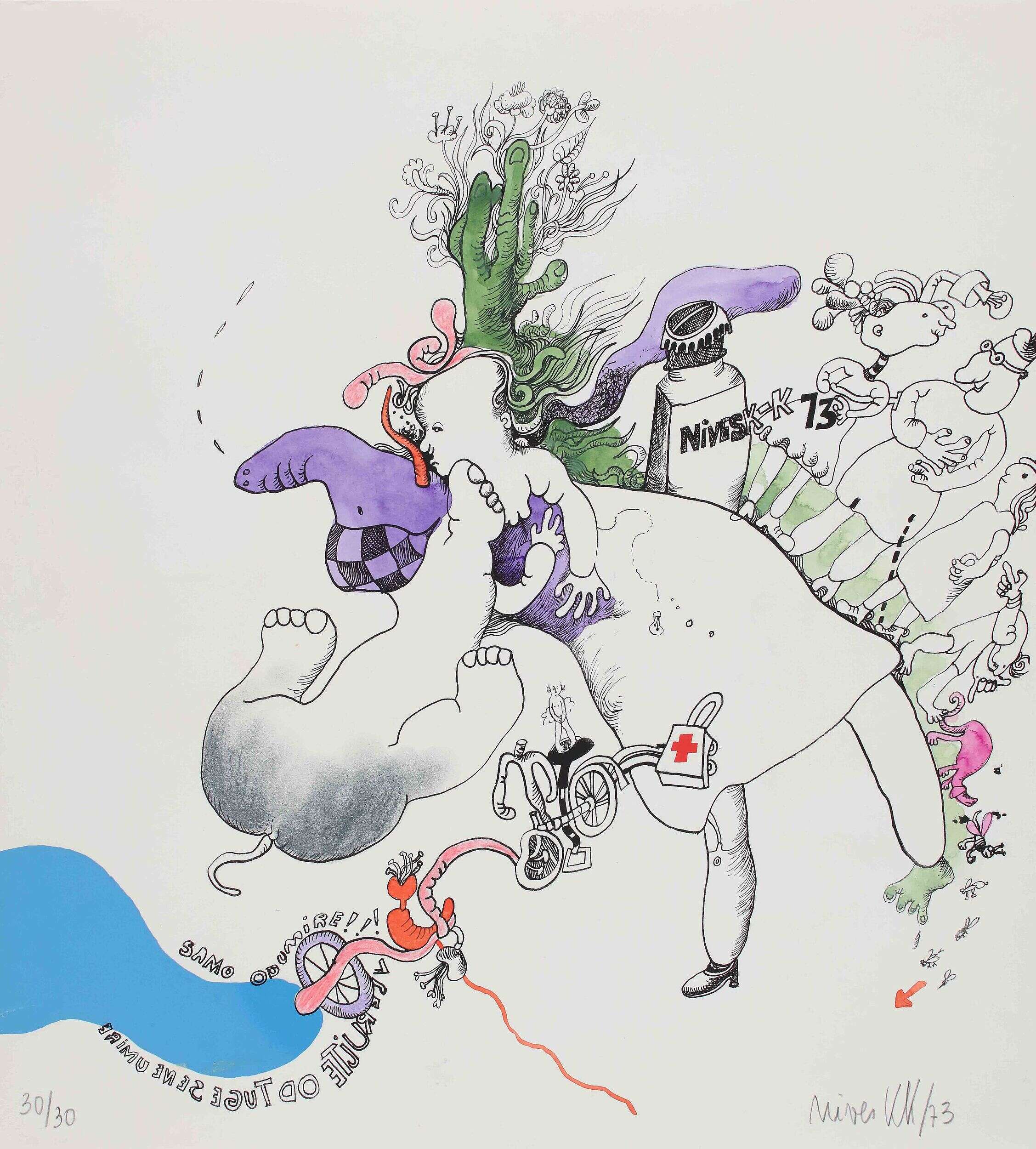
Believe me Sorrow does not make you die, it only breaks you down
ed. of the Biškupić Collection, Zagreb, 1973
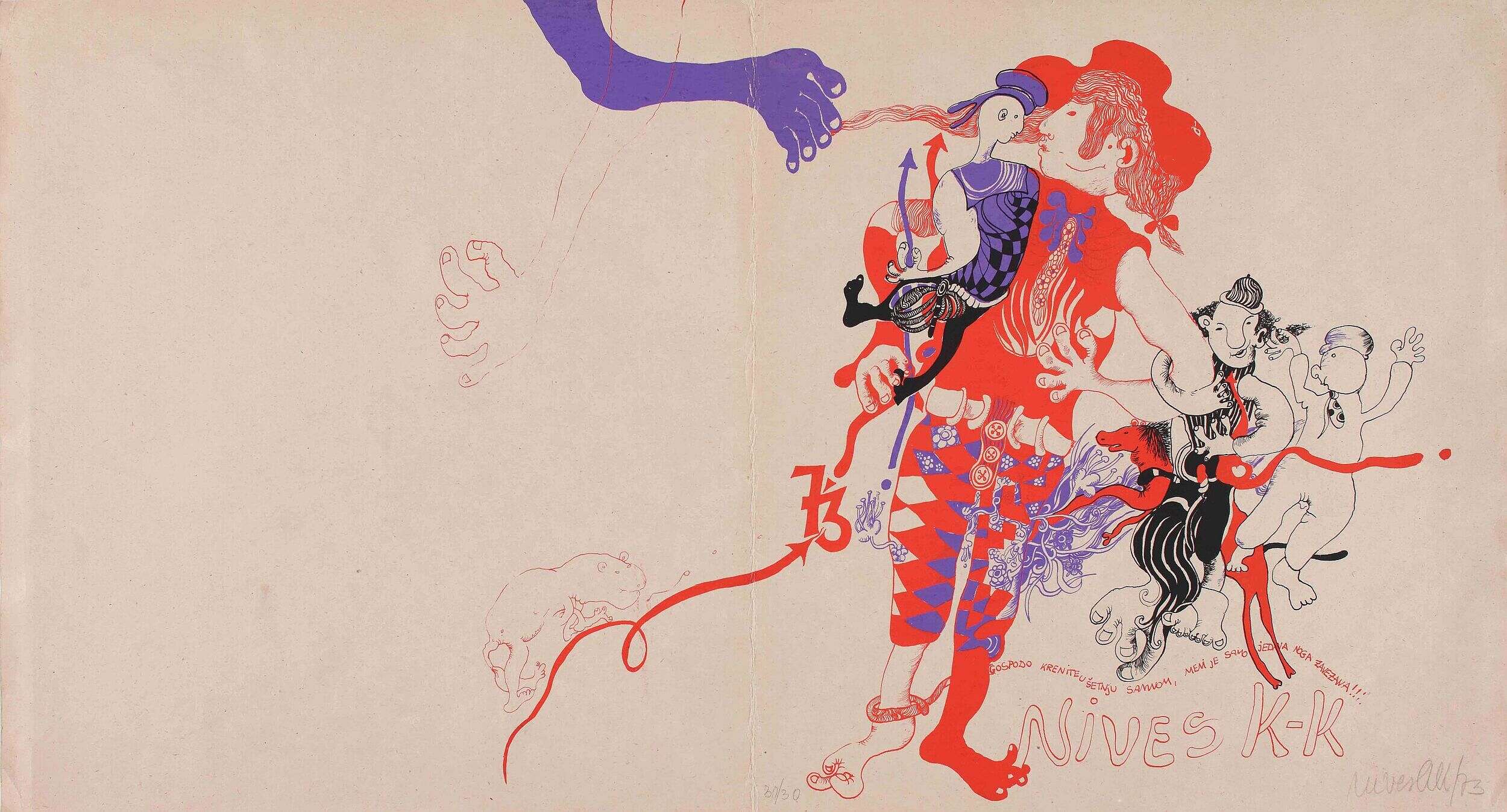
Title page of the print portfolio Nives K-K

Scattered Silence II, 1991
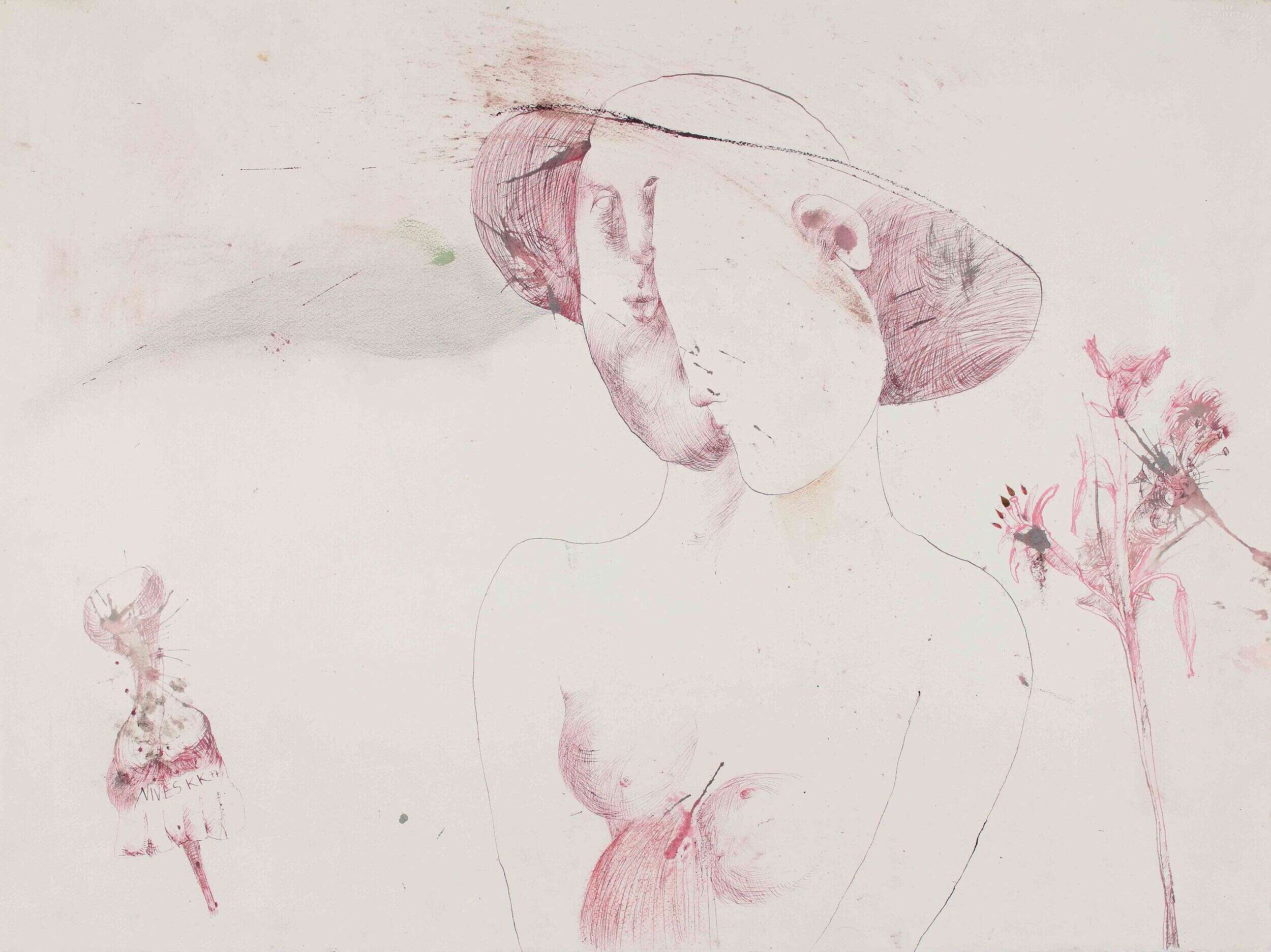
Premonition of Fruitage, 1977
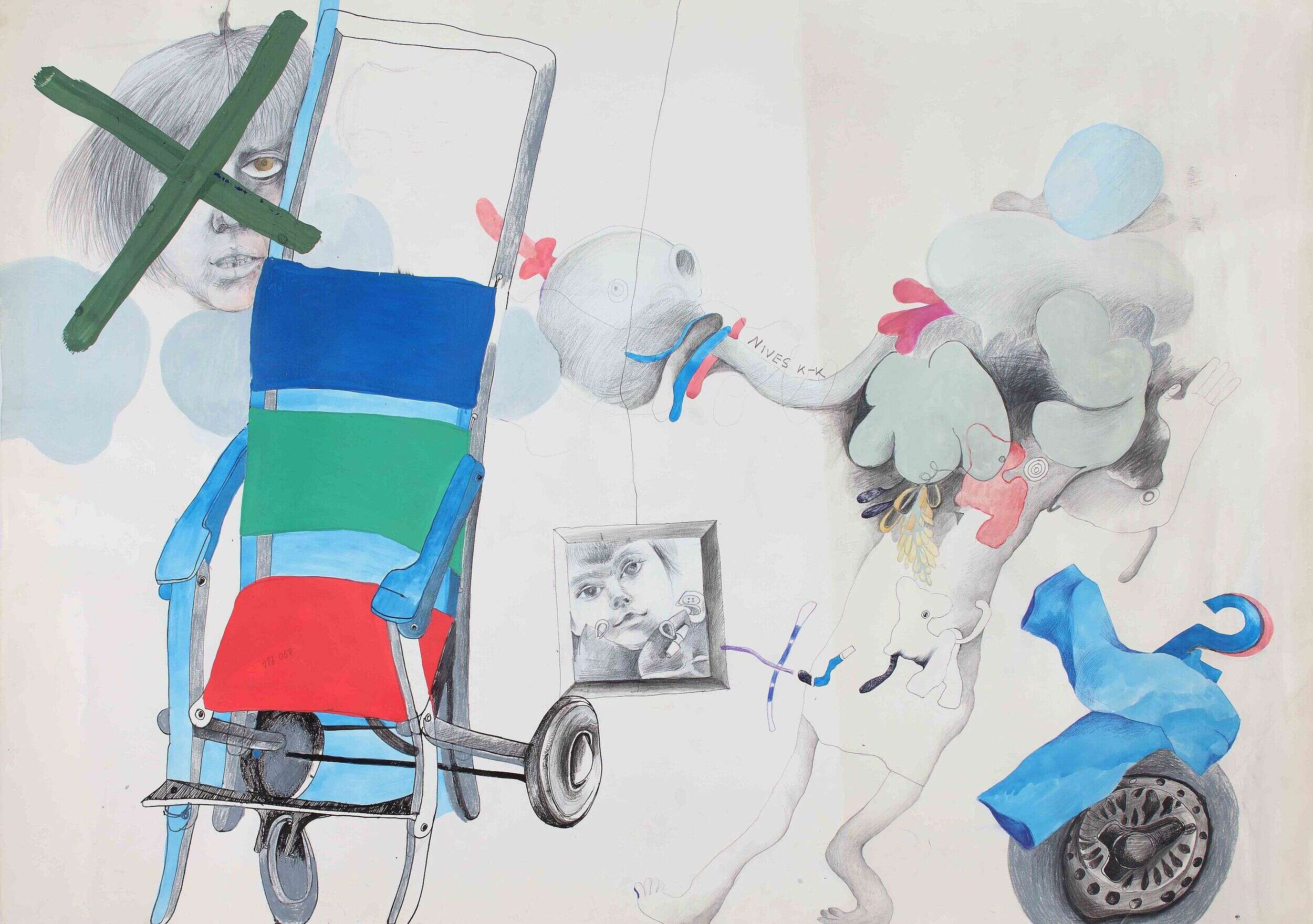
Reality Runway of Thoughts, 1970

Time of Wandering, 1968

Because!, 1963
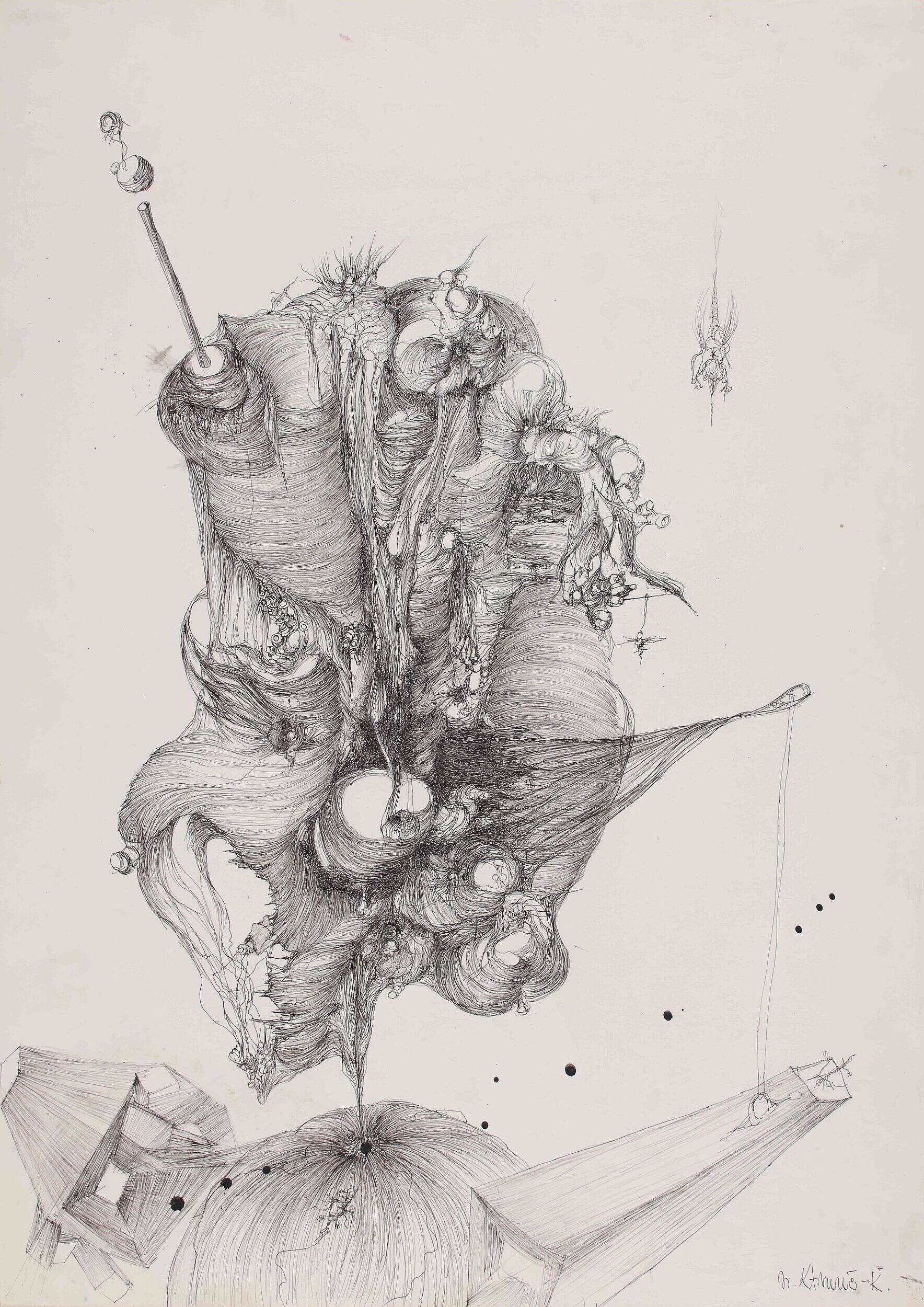
Hardship of Return, 1963
